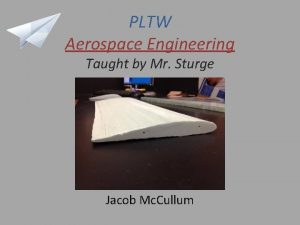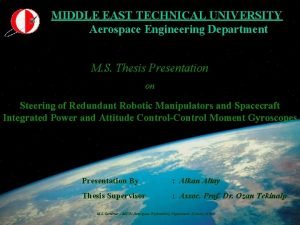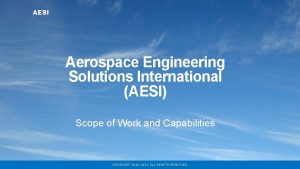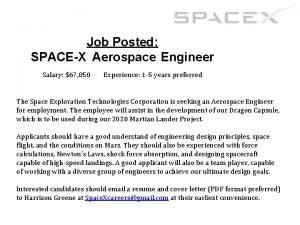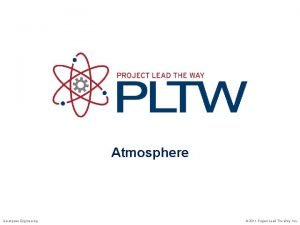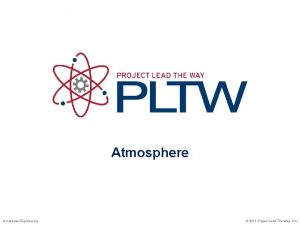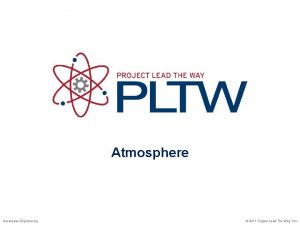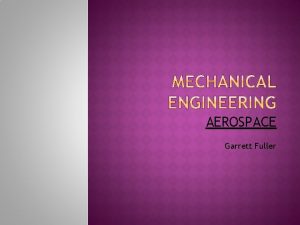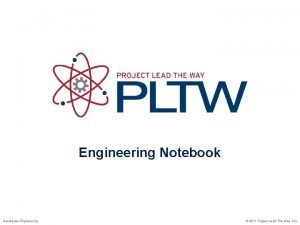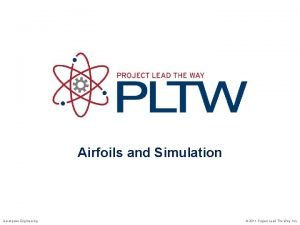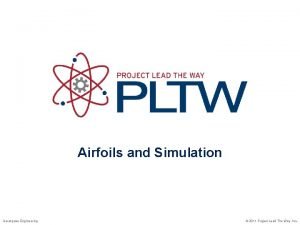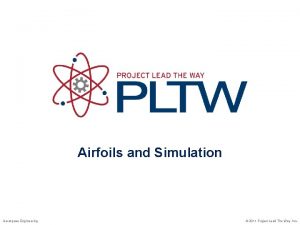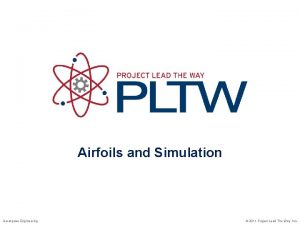Atmosphere Aerospace Engineering 2011 Project Lead The Way














- Slides: 14

Atmosphere Aerospace Engineering © 2011 Project Lead The Way, Inc.

Earth’s Atmosphere • Mixture of gases § 78% Nitrogen, 21% Oxygen and other gases § Sustains life § Protects us from solar radiation • Thin sheet of air 60 miles thick § Relative comparison § Basketball wrapped tightly with plastic sheet

Earth’s Atmosphere Layers § § § Troposphere Tropopause Stratosphere Mesosphere Thermosphere

Air Pressure • Air above exerts pressure below § 101. 3 k. Pa (14. 7 psi) means that column (97 km or 60 miles) of air sitting on two thumbnails is 5. 5 kg (14. 7 lb) § Density and pressure higher close to ground

Standard Atmospheric Conditions Aerospace engineers use a standard to compare measurements such as speed § 15 OC and 101. 3 k. Pa (Kilo Pascals) § 59 OF and 14. 7 psi

Earth’s Atmosphere Conditions

Earth’s Atmosphere Conditions Lapse rate in troposphere (11 km)

Earth’s Atmosphere Conditions • Air density changes based on pressure and temperature • Generally air density lowers as it climbs to higher altitudes

Earth’s Atmosphere Conditions • Mount Everest is 8, 848 m (29, 029 ft) tall • Similar altitude of jet aircraft • Climbers acclimatize over long period of time or breathe supplemental oxygen • Pilots must react quickly to receive supplemental oxygen if cabin loses pressure • Causes of pressure loss – Fuselage integrity failure (leak) – Window failure

Aircraft Speed

Aircraft Speed • Air molecules must move as aircraft passes through atmosphere • Air compressed at speeds beyond ~ 400 kph (250 mph) • Air resistance is significant when close to speed of sound • Transition to beyond speed of sound creates shock waves and sonic booms

Aircraft Speed • Mach (M) § Decimal number representing the true airspeed relationship to the local speed of sound: 1, 225 kph or 761 mph at sea level and standard conditions • • Subsonic: < Mach 1 Supersonic: Mach 1 and 5 Hypersonic: Mach 5 and 10 High-Hypersonic: Mach 10 and 25 § Speed of sound changes with temperature § Higher altitudes are cooler, so Mach threshold is lower

References Basic weather theory. In Jeppesen Private pilot: Guided flight discovery (pp. 6 -2 – 6 -7). (2007). Englewood, CO: Jeppesen Sanderson, Inc. (2006). Guided flight discovery commercial pilot images [CD-ROM]. Englewood, CO: Jeppesen Sanderson, Inc. National Aeronautics and Space Administration (2010). Atmosphere. Retrieved from http: //www. grc. nasa. gov/WWW/K 12/airplane/atmosmet. html US Navy. (1999). F/A-18 hornet breaks the sound barrier. Retrieved from http: //www. navy. mil/view_single. asp? id=1445

References Wikipedia. (2011). Mount Everest from Kalapatthar. Retrieved from http: //commons. wikimedia. org/wiki/File: Everest_kalapatt har. jpg
 Rit freshman orientation
Rit freshman orientation Project lead the way design process
Project lead the way design process Pltw aerospace engineering
Pltw aerospace engineering Metu aerospace engineering
Metu aerospace engineering Aerospace engineering solutions
Aerospace engineering solutions Phystech international
Phystech international Aerospace propulsion salary
Aerospace propulsion salary Lead magnesium niobate/lead titanate
Lead magnesium niobate/lead titanate Key club meaning
Key club meaning Perbedaan one way dan two way anova
Perbedaan one way dan two way anova Thread binary tree
Thread binary tree Perbedaan two way anova dan one way anova
Perbedaan two way anova dan one way anova One way two way anova
One way two way anova One way anova vs two way anova
One way anova vs two way anova Anova two way adalah
Anova two way adalah


